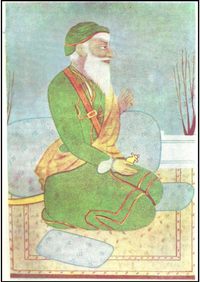I had earlier covered Ranjit Singh’s early life and the events leading to capture of Lahore, that laid the foundation of the Sikh Empire. Here I will be looking primarily at how he expanded his Empire, and his kingdom.

Ranjit Singh formally crowned himself as the Maharaja of Punjab in 1801, the investiture ceremony was carried out by Baba Sahib Singh Bedi , a descendant of Guru Nanak. Calling his rule as Sarkar Khalsa and his court as Darbar Khalsa, he ordered new coins to be issued in the name of Guru Nanak, called Nanakshahi.
He captured Amritsar in 1802, from the Bhangi Sikhs, and announced that the Harmandir Sahib which was desecrated by Afghans would be renovated with gold and marble. In 1807 he captured Qasur from the Afghans, it would also be the first independent expedition of Hari Singh Nalwa who would later play a major role in his campaigns.

Hari Singh Nalwa played a crucial role in expanding Ranjit Singh’s empire, especially his battles with the Afghans. It’s said Afghan mothers would put their kids to sleep with “Hari Ragla” such was the fear he inspired in them.He kept the entire Afghan force led by Dost Mohd Khan at bay, with just a handful of forces.Multan was conquered by Ranjit Singh in 1818, bringing the whole Bari Doab(current day Majha region in Punjab) under his control. While his first attempt to invade Kashmir in 1813-14 failed due to heavy rains, and stiff resistance by Afghans, he managed to capture it by 1818, appointing Dewan Moti Ram as Governor.
One of his major achievements was the successful battles against the Afghans, whom he managed to subdue. Dewan Mokham Chand, one of Ranjit Singh’s trusted generals, played a crucial role at the Battle of Attock, against the Afghans. Attock was one of the crucial forts, in the Khyber Pass, it was strategically important for both Afghans and Sikhs. He led the charge against the Afghans at Attock in 1813, under Dost Muhammad Khan,one of their prominent leaders. In an intense battle, Mokham Chand mounted a deep cavalry charge on top of an elephant, routing the Afghans. So significant was the impact of this victory, that Amritsar, Lahore were illuminated for 2 months to celebrate it.

Dost Muhammed accepted Ranjit Singh’s sovereignity over Peshawar,agreeing to pay him a revenue of Rs 1 lakh per year. He also acquired Dera Ghazi Khan, Hazara and Mankera between the Jhelum and Indus from 1820-21.
Battle of Jamrud was the last major Afghan-Sikh confrontation, where Nalwa fought the Afghans till his last breath. While Nalwa died in the Battle of Jamrud, he ensured his spirited resistance, would make the Afghan forces retreat. Other famous generals were Veer Singh Dhillon,from Gurdaspur, who captured the entire Eastern Punjab. And Zorawar Singh who conquered Ladakh, Baltistan, and went all the way up to Tibet.
Hari Singh Nalwa’s death was however a major blow to Ranjit Singh, the Sikh empire was restricted till the Khyber, cud not expand more. Under him the Sikh Empire covered the entire Punjab, the hill states, Kashmir, Gilgit, Khyber Pass and part of W.Tibet. He generally had a secular rule,where all faiths were respected, and had freedom to practice their own. His army and court, consisted of equal number of Hindu, Sikhs and Muslims, some European officers too.
Ranjit Singh also employed many European officers to train his army, in the latest techniques and strategies. He organized his army on an European model, where the cavalry was based on British system, and a French style infantry. Jean Francois Allard, was one of the French generals in Ranjit Singh’s Army, he was the one who organized the cavalry. Along with another European officer Jean Baptiste Ventura, commanded the Army in Battle of Nowshera, defeating the Afghans.
Another European officer Claude Auguste Court, was responsible for the training of Ranjit Singh’s artillerymen and establishment of arsenal. Before the Sikh Army was mainly cavalry based, under him, infantry and artillery gained importance too.
Ranjit Singh also renovated the Golden Temple, most of the intricate marble work there and the gold gilding was his contribution. He also built the Patna Sahib Gurudwara, considered one of the Paanch Takt of Sikhism. The Takht Huzur Sahib Gurudwara at Nanded was also built by Ranjit Singh, in tribute to Guru Gobind Singh. Apart from being a great warrior, Ranjit Singh was an equally wise and able ruler, provided an effective governance to his subjects.
One important measure by Ranjit Singh was banning cow slaughter in his empire. Even the European officers in his army, were expected to follow this rule. Though Ranjit Singh recruited European officers, he insisted they follow the Sikh code of conduct. They were not allowed to eat beef, smoke or cut their hair. In fact they more or less adopted the Sikh traditions, while under the service of Ranjit Singh. While a devout Sikh, Ranjit Singh, gave equal respect to Hinduism, took part in the reciting of Vedic hymns in temples. His royal priest, Raj Guru, was a Hindu, whose son later became the ruler of Gurshankar in Punab.
This was Maharaja Ranjit Singh’s empire at it’s peak, as you can see he controlled the entire North West.

His period was to the Sikhs, what Shivaji’s was to the Marathas, one of the finest eras in their history. Forging a loose confederation of Sikh Misls into a single kingdom, and expanding it into an empire, was his greatest achievement ever.


